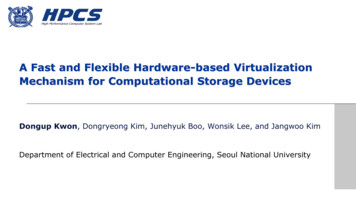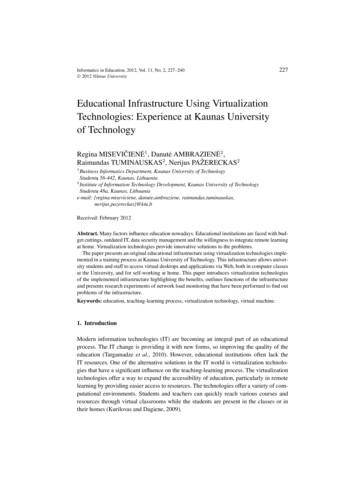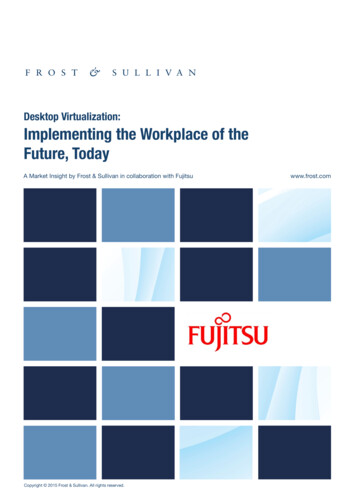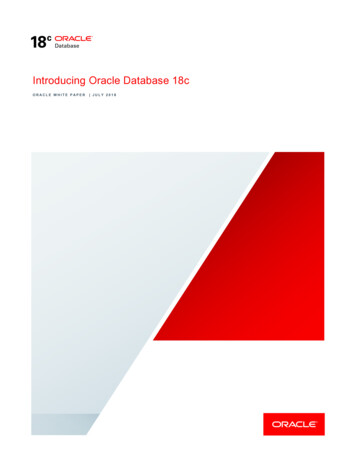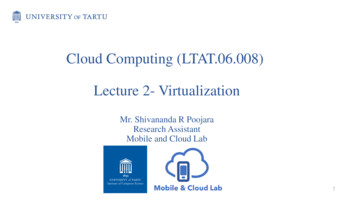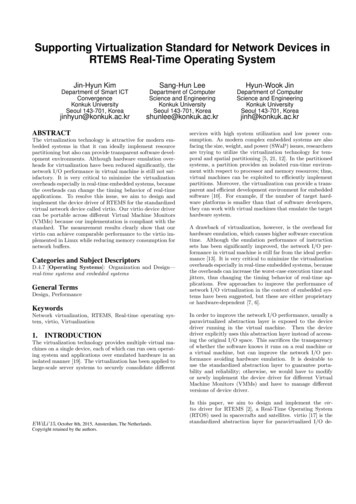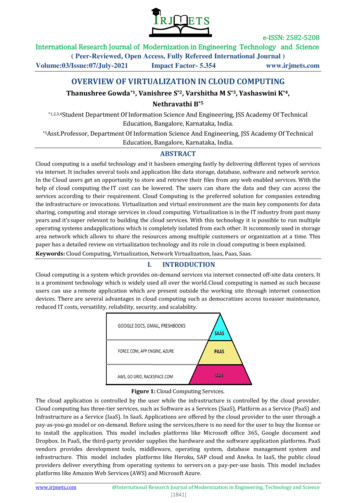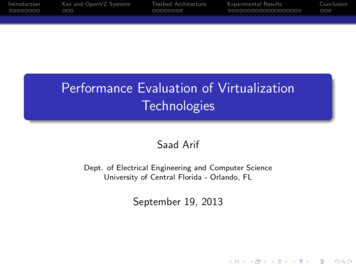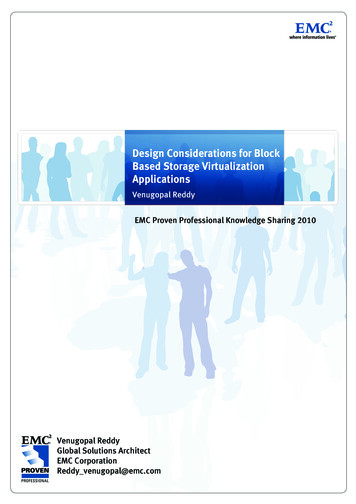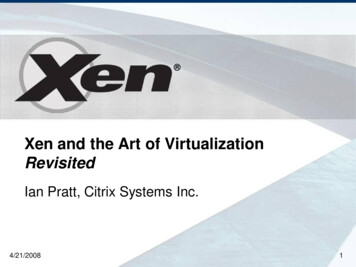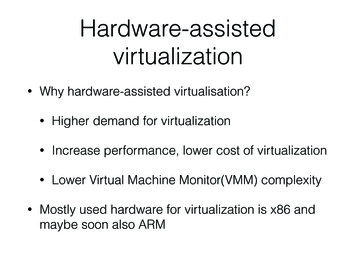
Transcription
Hardware-assistedvirtualization Why hardware-assisted virtualisation? Higher demand for virtualization Increase performance, lower cost of virtualization Lower Virtual Machine Monitor(VMM) complexityMostly used hardware for virtualization is x86 andmaybe soon also ARM
Timeline x86 Before 2005 After 2005, CPU virtualization Binary translationTrap and emulate, Intel VT-x, AMD-VAfter 2010, Memory virtualization Second Level Address Translation, Intel Extended Page Table(EPT), AMD RapidVirtualization Indexing(RVI) Device virtualisation, Intel VT-d, AMD-ViAfter 2013, CPU virtualization Nested virtual machines, Intel Virtual machine Control Structure(VMCS) shadowing
Why can't x86 be classicallyvirtualized? Classically means virtualized with trap and emulate Visibility of privilege state(Ring, %cs) Lack of trap on privileged instructions running atuser-level(Ring 3) Example: popf instruction Same instruction behaves differentlydepending on privileged state User Mode(Ring 3): changes ALU flags likethe ZeroFlag(ZF) Kernel Mode(Ring 0): changes ALU andsystem flags like Interrupt Flag(IF) Does not generate a trap in user mode(Ring3)
Binary Translation Interpret the binary code x86 x86 assembly Most instructions remain identical, except control flow(calls, jumps, branches, ret, etc.), and privilegedinstructions Avoids traps, which can be expensive Translation cache is used to speed up
Trap & Emulate GuestOSprivilegedinstruction trapresource emulate changevmmchangeresource5Run guest VM inunprivileged modeExecute guest instructionson real CPU when possible E.g., addl %eax, %exPrivileged instructions trap,and VMM emulates E.g., movl %eax, %cr3 Traps into VMM so theeffect can be emulated
Enable trap and emulate A new set of CPU protection rings for guest(non-root) mode inaddition to the old host(root) mode New instructions for moving between host and guest modecalled “VMRUN” and also instructions for setting the new VirtualMachine Control Structure(VMCS) pointer. VMM fills the VMCS and execute “VMRUN”VMM software emulation still needed.
Memory Virtualization Traditionally, Host OS fully controls all physical memory space andprovides a continuous addressing space(virtual addresses) to eachprocess Guest OS is just one of many user space processes, but under VMMcontrol In system virtualization, VMM should make all virtual machines share thesame physical memory space Before HW support, Shadow Page Tables Second Level Address Translation(SLAT), Intel EPT, AMD RVIVirtual memory and MMU
Virtual Memory Each process has its own space(usually starting at 0x0) A memory page is a fixedlength contiguous block (4KB, 2 MB)of data used for memory allocation A page table keeps all mappingbetween the virtual blocks andphysical blocks where data isstored. It also contains read, writeand execute flags on the blocks. Virtual memory enables memoryisolation between user processes
Memory Management Unit A hardware component responsible for handlingaccesses to memory requested by the CPU Address translation: virtual address to physicaladdress (VA to PA) Memory protection(read/write/execute) Cache control Bus arbitration The MMU keeps a in-memory(RAM) table called pagetable that maps logical pages to physical pages.
Page Tables A page table is the data structure used by a virtualmemory system to store the mapping betweenvirtual addresses and physical addresses Page table base register(PTBR, %cr3 on x86) Stores the address of the base page table for MMU10
Translation Look-asideBuffer(TLB) Translation look-aside buffer A CPU cache that MMU hardware uses to improve virtualaddress translation speedAvoid accessing and walking the page table in main memoryThe search key is the virtual address and the search result is aphysical address
Memory VirtualizationArchitecture
Software memoryvirtualization VMM creates and maintains page tables that map guest virtualpages directly to machine pages, called the shadow page table In each VM, OS creates and manages its own page table Shadow page table is the one used by the MMUNot used by MMU HardwareGuest page table is protected from writing with MMU by VMM Manipulation of the guest page table is tracked, and theVMM updates the shadow page table and the guest pagetable accordingly
In shadow paging the VMM maintains PPN- MPN mappings in its internal data structures and storesLPN- MPN mappings in shadow page tables that are exposed to the hardware (see Figure 2). The mostrecently used LPN- MPN translations are cached in the hardware TLB. The VMM keeps these shadow pagetables synchronized to the guest page tables. This synchronization introduces virtualization overhead whenthe guest updates its page tables.Shadow page tableFigure 2. Shadow Page Tables DiagramVirtual Machine #1Process 1Process 2Virtual Machine #2Process 1Process 2LogicalPagesPhysicalPagesShadow Page TableEntryMachinePages
Hardware memoryvirtualization Second Level Address Translation(SLAT), Intel EPT, AMD RVI Shadow page tables now handled by hardware. Two page tables are exposed to hardware The EPT its set with an entry in the VMCS One walker does Guest VA - PA on page table managed by VM One walker does Guest PA - MA on page table managed byVMMTLB miss create extra penalty due to the extra walk in nestedpage table15
Extended Page Table Memory operation :698478Data
Cost Binary translation vs VT-x(2005), VMWare
Time (Normalized to0.60.400.40.37Gain0.20.01vCPU 0.462vCPUs0.270.194vCPUs8vCPUsNumber of Virtual CPUsSecond level address translation(EPT) gainTime (Normalized to 1 vCPU SW MMU)Figure 7. 64-bit Apache Compile Time (Lower is Better)1.21.01.00SW vCPU2vCPUs4vCPUsNumber of Virtual CPUs8vCPUs
5.9. FUTURE WORKAgain VMWare performance better than KVM and very close to Bare Metal. KVMadded more overhead in file system throughput and is needed improvement in this areafor better results.Cost 5.8.4Composite Throughput scoreBare metal comparison 2012, CPU, IPC, filesystemFigure 5.33: UnixBench composite throughput score
Device virtualization Needs CPU, chipset and system firmware support I/O MMU virtualization(Intel VT-d, AMD-Vi) For full control over devices with DMA and interrupt remapping. Devices on PCI bus must support Function Level Reset(FLR)Network virtualization(Intel VT-c) Intel I/O accelerated Technologies for reduction of CPU loads Virtual machine device queues(VMDq) Single root I/O virtualization(SR-IOV) Allows PCIe devices to appear to be multiple separate physical devices, good forNIC. Network interface with support can get up to 95% performance of bare metal.20
Device VirtualizationEmulated I/OHosted or SplitPassthrough I/OHypervisor DirectGuest OSGuest OSGuest OSDevice DriverDevice DriverDevice DriverHost OS/Dom0/Parent DomainDevice EmulationDevice EmulationDevice EmulationI/O StackI/O StackDeviceDevice DriverDevice DriverManager
Timeline ARM Before 2013 Binary translation, if any :)After 2013 Trap and emulate, ARMv7 with extensions andARMv8
These results provide the first comparison of ARMand x86 virtualization extensions on real hardware toquantitatively demonstrate how the different designchoices affect virtualization performance. We showthat KVM/ARM also provides power efficiency benefitsover Linux x86 KVM.Finally, we make several recommendations regardingfuture hardware support for virtualization based on ourexperiences building and evaluating a complete ARMhypervisor. We identify features that are important andhelpful to reduce the software complexity of hypervisorimplementation, and discuss mechanisms useful to maximize hypervisor performance, especially in the contextof multicore systems.This technical report describes our experiences designing, implementing, and evaluating KVM/ARM. Section 2 presents an overview of the ARM virtualizationextensions and a comparison with x86. Section 3 describes the design of the KVM/ARM hypervisor. Section 4 discusses the implementation of KVM/ARM andour experiences releasing it to the Linux community andhaving it adopted into the mainline Linux kernel. Section 5 presents experimental results quantifying the performance and energy efficiency of KVM/ARM, as wellas a quantitative comparison of real ARM and x86 virtualization hardware. Section 6 makes several recommendations about designing hardware support for virtualization. Section 7 discusses related work. Finally, wepresent some concluding remarks.as digital rights management. TrustZone may appearuseful for virtualization by using the secure world for hypervisor execution, but this does not work because thereis no support for trap-and-emulate. There is no means totrap operations executed in the non-secure world to thesecure world. Non-secure software can therefore freelyconfigure, for example, virtual memory. Any softwarerunning in the non-secure world therefore has access toall non-secure memory, making it impossible to isolatemultiple VMs running in the non-secure world.ARM vs x86 CPU virtualization Secure ces hyp mode below kernel mode.Monitor Mode (Secure PL1)Figure 1: ARMv7 CPU modes.No hardware support for saving and restoring gueststates.Memory virtualisation Non-Secure state2Hyp mode was introduced as a trap-and-emulatemechanism to support virtualization in the non-secureworld. Hyp mode is a CPU mode that is strictlymore privileged than other CPU modes, user and kernel modes. Without Hyp mode, the OS kernel runningin kernel mode directly manages the hardware and cannatively execute sensitive instructions. With Hyp modeenabled, the kernel continues running in kernel mode butthe hardware will instead trap into Hyp mode on varioussensitive instructions and hardware interrupts. To runVMs, the hypervisor must at least partially reside in Hypmode. The VM will execute normally in user and ker-ARM Virtualization ExtensionsMore or less the samefunction as EPTBecause the ARM architecture is not classically virtual-I/O virtualizationizable [20], ARM has introduced hardware virtualizationsupport as an optional extension in the latest ARMv7architecture [4] and a mandatory part of the upcoming2 Uses MMU to trap access to non RAM memory x86 uses special instructions(inl, outl) for accessing MMIO
ARM vs x86 Interrupt virtualization ARM extends the Global interrupt Controller(GIC) withvirtualization support(VGIC) VMM can program GIC to trap directly to guest kernel mode forvirtual and physical interrupts. Shared device access must trap to hyp mode.Timer virtualization Virtual timers and counters. Controlled from guest without trap to hyp mode.
ARM vs x86 cost FIX ME25
Virtual end
ncy benefitss regardingased on ourplete ARMportant andhypervisoreful to maxthe contextriences deARM. Secrtualizationction 3 devisor. SecM/ARM andmunity andernel. Secing the perRM, as wellnd x86 vireral recom-trap operations executed in the non-secure world to thesecure world. Non-secure software can therefore freelyconfigure, for example, virtual memory. Any softwarerunning in the non-secure world therefore has access toall non-secure memory, making it impossible to isolatemultiple VMs running in the non-secure world.ARM vs x86Non-Secure stateSecure statePL0UserPL0UserPL1KernelPL1KernelPL2HypMonitor Mode (Secure PL1)Figure 1: ARMv7 CPU modes.Hyp mode was introduced as a trap-and-emulate
and x86 virtualization extensions on real hardware to quantitatively demonstrate how the different design choices affect virtualization performance. We show that KVM/ARM also provides power efficiency benefits over Linux x86 KVM. Finally, we make several recommendations regarding future hardware support for virtualization based on our
